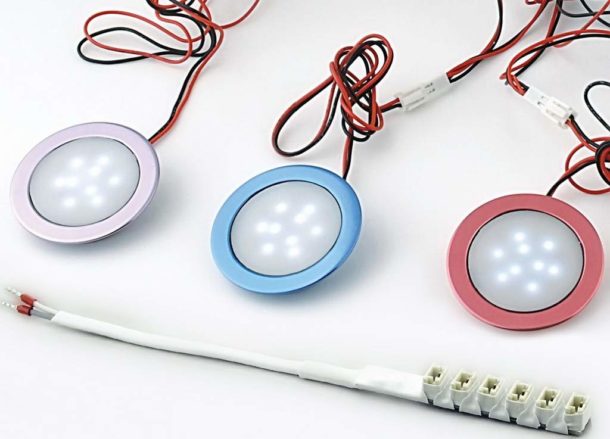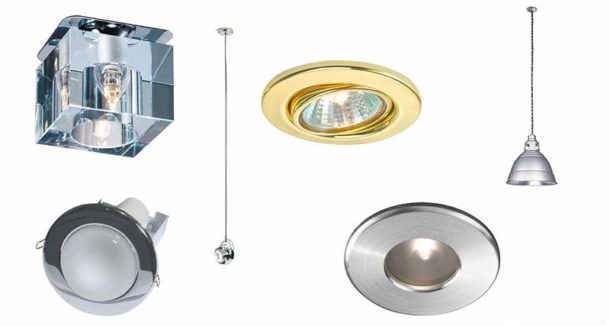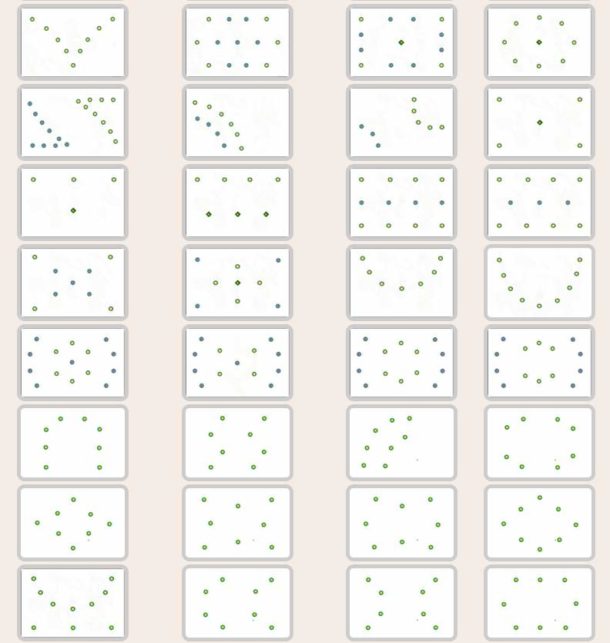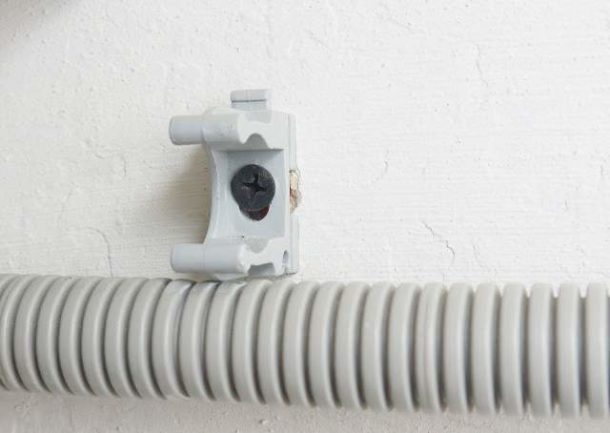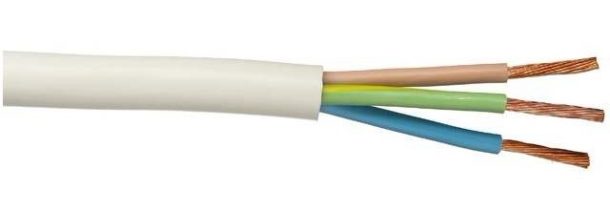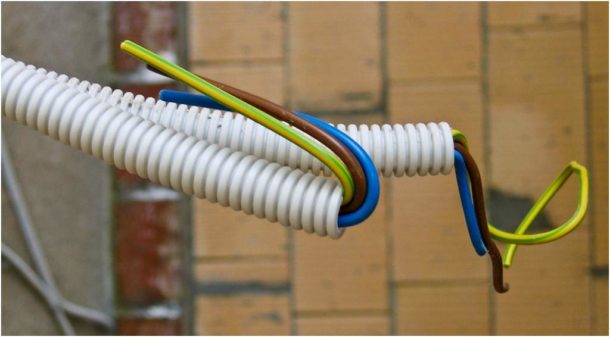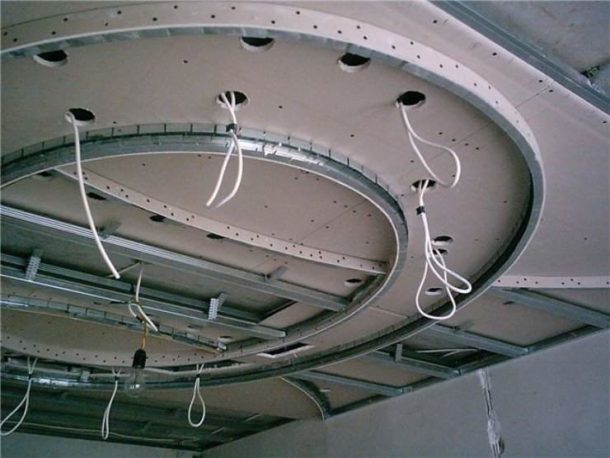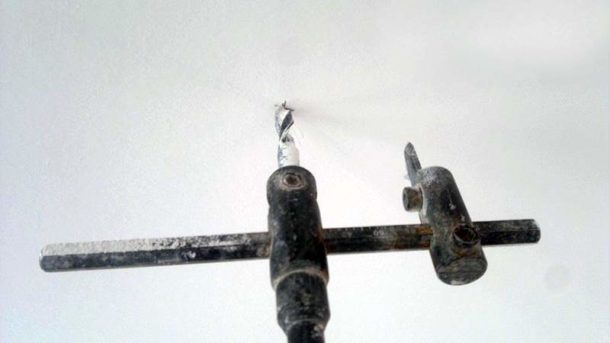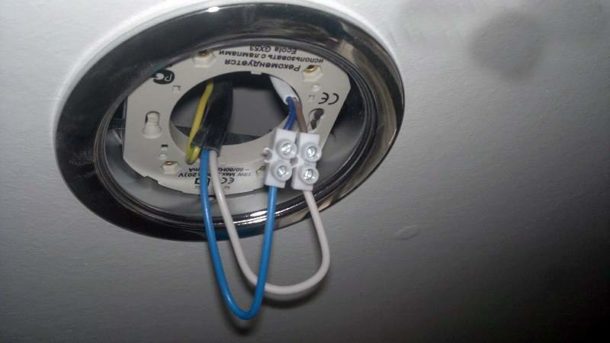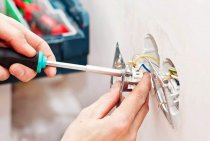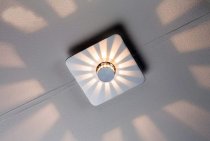Plasterboard ceiling structures make the ceiling level somewhat lower, and in some cases standard chandeliers look bulky and not very organic on them. Installing spotlights in drywall on the ceiling will be the best solution that can be used both independently and in combination with a central lighting fixture. A group of point lighting devices will allow you to delimit the space, highlight certain areas of the room, evenly illuminate the room, and create interesting effects on the ceiling.
Types of spotlights
Spotlights designed for plasterboard ceilingsare classified according to several parameters. By type of installation, the following types are distinguished:
- built-in - inserted into a hole in the ceiling, after installation only the decorative part is visible;
- overhead - mounted on a solid surface, a hole in the drywall is made only for wires.
Structurally, the lamps are:
- fixed;
- rotary.
In spot lighting devices, different types of lamps are used:
- halogen;
- LED;
- luminescent;
- incandescent lamps with a mirror reflector.
Everyone chooses them at their own discretion, guided by economy, price and other factors. The most efficient are LED lights, but many are put off by the price. However, if you take lamps from reputable suppliers and manufacturers, they pay off because they are durable and emit the least heat. The most inefficient are incandescent lamps: they get very hot and “eat up” the most electricity, although they are cheaper than the rest.
Placement of lighting fixtures on the ceiling
Spot lighting fixtures can be placed on the ceiling in several ways.
- In straight rows along a line perpendicular to the window, with a step of no more than 80-100 cm and at a distance of about 60 cm from the wall.
- In a checkerboard pattern. The method is well suited for living rooms and provides them with full lighting.
- Peripheral lighting. Well suited as additional lighting in the presence of a central chandelier. The distance between the lamps is 80 cm, and the distance from the walls is 40 cm.
The above schemes can be combined with each other.
Preparing for installation
When arranging the ceiling, it is necessary to begin the installation of spotlights immediately after installing the frame under the drywall.
- First, a layout of lighting fixtures is drawn up.
- being laid wiring. It is convenient to do it on the ceiling, after fixing special clips on it that hold the cable taut.
- The cores from the cable go down to the lamps. The connection is made via terminal contacts.
It is possible to lay wiring through the holes in the profiles, if they are provided for in the design. It is not recommended to cut them yourself, so as not to loosen the ceiling mount.
A few tips:
- For lighting, it is convenient to lay a flexible cable with three cores with a cross section of 1.5 mm2.
- Powerful light sources are not recommended. Economical models of lamps are selected, which are equivalent in luminous intensity to incandescent lamps with a power of 35–40 W.
- The ability to quickly replace the luminaire allows you to choose the device that is most suitable in terms of power, color temperature and scattering angle in the future.
Wiring
The wires are laid to the lamps in the corrugated pipe.
The junction box should be located in an accessible place so that you can later check the health of the wiring through it.It also does not hurt to lay a backup cable from it in a separate corrugation in case the faulty wire is replaced in the future. Although the ceiling will be covered with drywall, the cable will be accessible through holes in the ceiling and can be pulled to any fixture.
If a fire-resistant cable is used, it is not necessary to use corrugation. But still, it is recommended to install it at least at the entrance to the interceiling space. Through the corrugated pipe it is convenient to pull out the wires that have come out of the stand and insert new ones, so it should be placed in a straight line from the junction box.
The connection is parallel everywhere: so it will be easy to find a burned-out light bulb. When connected in series, the failure of one lamp leads to the shutdown of the others.
Low voltage lamps are often used: 12 V and 24 V. This is safe, but an additional power supply is required. It is better to place it somewhere below or in a hidden ceiling niche for ease of maintenance.
Important! Even before installing the GKL, it is necessary to check the serviceability of the wiring, which can fail during installation.
How to cut holes in drywall for lights?
Marking for lighting fixtures on drywall sheets (GKL) is done before attaching to the frame. After all the sheets are fixed, you can adjust the location of the fixtures so that they are evenly placed on the ceiling. This will not affect the quality of their connection to the wiring, since the wires are laid with a margin.
Holes in drywall are cut using a drill with a special crown. This can be done with a clerical knife, but the quality will be worse. The edges of the hole should be treated with a primer.
Installing a spotlight in the ceiling
Installation of spotlights in drywall is done when the finish coating has already been applied to the ceiling. Work should be done carefully so that the decorative coating remains intact.
- The wiring is de-energized, after which its ends are pulled through the holes in the drywall and connected to the terminal blocks or clamps of the spotlights. To do this, the cartridge is untwisted and separated from the body. Two lead wires - phase and neutral - are connected to the terminal block of the cartridge.
- Spring-loaded antennae are fixed on the body of most lamps. They are brought together and the fixtures are inserted into the drywall through the holes in the ceiling. The springs spread the antennae and press the body against the drywall from the back.
- The cartridge is removed through the hole in the housing and connected to the lamp.
- Then it is inserted into the body and fastened with a retaining ring.
- Before final fixing, turn on the power and check the operation of the lamp.
The method of mounting fixtures may vary. Before installing them, you should read the instructions, where all operations should be described in detail.
Note! All lamps are connected in parallel with a loop. The main wire is not cut, but remains solid, with the exception of the removed insulation at the connection points. This leaves a margin of the supply cable for possible subsequent connections.
The wires are connected by soldering (twisting is not allowed) with subsequent insulation.
Schemes for switching on lamps can be different. To connect individual sections, apply two- and three-gang switches.
Conclusion
It is quite possible to install a recessed spotlight with your own hands. It is important to follow two basic rules: the distance between them should be no more than 1 m, and the power of the bulbs is chosen to be average, not leading to overheating of the electrical system and the ceiling.
